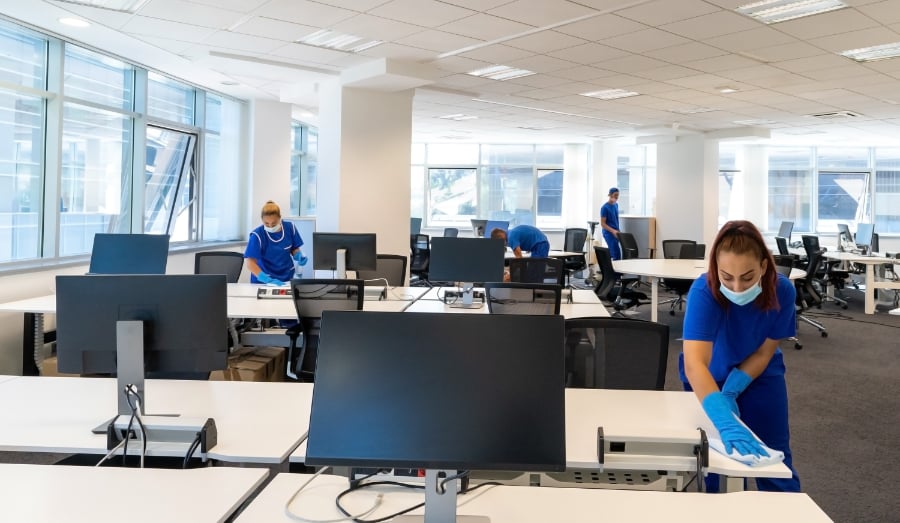
Guest post by David Cruz. David has been a freelance writer for nearly five years, covering a wide array of topics ranging from FinTech to residential real estate.
As the brunt of the COVID pandemic has begun to abate, many companies are reopening their doors to employees in varying capacities. People are going back to their desks, cubicles, and common areas such as lunchrooms and meeting spaces where most of the workplace germs and viruses are transmitted through human contact and shared surfaces.
With the way we’ve learned coronavirus spreads in close quarters, and the need for the diligent practices of office cleanliness and workplace safety fresh in everyone’s minds, now is a good time to review a best-practices guide that focuses on the frequency and level of cleaning that businesses should institute as part of their everyday policies.
Take an angled look across the broad mahogany conference table, underneath the edges, or around the AV equipment, where all the buttons live. Move aside the microwave, fridge, and coffee maker. Look behind them and scan the counter and tabletops and where coworkers talk shop while having lunch together.
More than a hundred hands a day touch these areas and can become a source of sickness that passes through the office like wildfire and infect colleagues. This can interrupt the workflow when project teams are depleted by the onset of illness, and runs counter-intuitive to the end goal of seamless productivity in the workplace.
To avoid—or, at the very least—limit these outbreaks, workplace safety and office cleanliness is of utmost importance as the world resumes its former workday routine.
1. Define a Workplace Safety Policy
Develop your plan: Determine what needs to be cleaned and how often. Consider the type of surface and how often the surface is touched. Generally, the more people who touch a surface, the higher the risk. Prioritize cleaning high-traffic areas.
Determine How Often To Clean
- The clear mission for high-touch surfaces is to sanitize or disinfect every day.
- More frequent cleaning might be needed when the space is occupied by those who may not consistently wear masks, wash hands, or cover coughs and sneezes.
- If the space is a high-traffic area, such as kitchens, bathrooms, or doors, it may be prudent to clean more frequently than once a day.
Determine If Regular Disinfection Is Needed
In most situations, regular cleaning (at least once a day) is enough to sufficiently remove viruses that may be on surfaces and ensure office cleanliness. However, if certain conditions apply, you may choose to disinfect after cleaning.
Consider the Resources and Equipment Needed
Keep in mind the availability of cleaning products and cleaners and disinfectants are appropriate, and (if needed), a higher grade at the level of PPE.
2. Implement and Educate
A plan is only a plan until it’s put into practice. Supervisors must inform their teams about what the policy is for cleaning to ensure workplace safety and office cleanliness.
Starting with those high traffic areas or high-touch surfaces, here are some examples: pens, counters, shopping carts, tables, doorknobs, light switches, handles, stair rails, elevator buttons, desks, keyboards, phones, toilets, faucets, and sinks.
3. Protect Yourself and the Cleaning Staff
Office cleanliness should go hand-in-hand with workplace safety. Take precautions with personal protective equipment to protect yourself, your coworkers, and the cleaning crew.
-
Ensure cleaning staff are trained on proper use of cleaning and disinfectant products.
-
Wear gloves for all tasks in the cleaning process.
-
Wash your hands with soap and water for 20 seconds after cleaning. Be sure to wash your hands immediately after removing gloves. If hands are visibly dirty, always wash hands with soap and water. If soap and water are not available and hands are not visibly dirty, use an alcohol-based hand sanitizer that contains at least 60% alcohol, and wash with soap and water as soon as you can.
-
Special considerations should be made for people with asthma. Some cleaning and disinfection products can trigger asthma. Make sure to consult your primary doctor about what disinfectants could trigger an attack.
Disinfect Safely When Needed
If you determine that regular disinfection may be needed:
-
If your disinfectant product label does not specify that it can be used for both cleaning and disinfection, clean visibly dirty surfaces with soap or detergent before disinfection.
-
Use a cleaning product that is effective against CRE and COVID-19.
-
If disinfectants for CRE or Coronavirus (COVID-19) are not available, bleach solutions can be used if appropriate for the surface.
-
Always follow the directions on the label to ensure safe and effective use of the product. The label will include safety information and application instructions. Keep disinfectants out of the reach of children. Many products recommend keeping the surface wet with a disinfectant for a certain period (see product label).
Always Take Necessary Safety Precautions:
-
Ensure adequate ventilation while using the product.
-
Wear gloves. Gloves should be removed carefully to avoid contamination of the wearer and the surrounding area.
-
Additional protective gear, such as glasses or goggles, might be required, depending on the cleaning/disinfectant products being used and whether there is a risk of splash.
-
Do not mix products or chemicals.
-
Do not eat, drink, breathe, or inject cleaning and disinfection products into your body or apply directly to your skin. They can cause serious harm.
-
Do not wipe or bathe people or pets with any surface cleaning and disinfection products.
With some detailed forethought, a plan shared with all employees, and the right equipment and supplies, office cleanliness and workplace safety will create an environment that eliminates the most germs and viruses that cause the spread of illness. By following the guidelines above, companies can boost their productivity and give their employees the healthiest experience possible.
Here are a few other articles to check out:
8 Working From Home Tips You Should Know
4 Site Selection Tips When Looking for Office Space
5 Tips When Moving Your Office From Big Cities to the Suburbs
Subscribe for more great CRE tips!!








